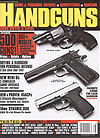
New Kahr CW9 9mm
Proven performance at a price that can't be beat!
Handguns 2006 Buyer's Guide, p.4-9 By Mike Detty
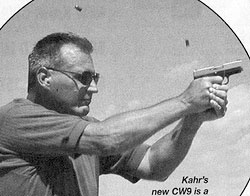 Kahr's new CW9 is a pleasure to shoot and very controllable.
Kahr's new CW9 is a pleasure to shoot and very controllable.
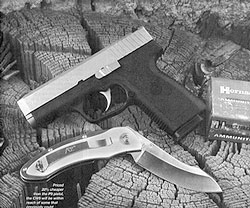 Priced 20% cheaper than the P9 pistol, the CW9 will be within reach of some that previously could not afford a Kahr.
Priced 20% cheaper than the P9 pistol, the CW9 will be within reach of some that previously could not afford a Kahr.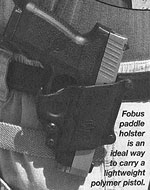 Fobus paddle holster is an ideal way to carry a lightweight polymer pistol.
Fobus paddle holster is an ideal way to carry a lightweight polymer pistol.
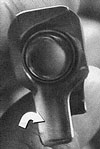 Its patented offset feed ramp allows the trigger mechanism to ride next to the feed ramp instead of under it.
Its patented offset feed ramp allows the trigger mechanism to ride next to the feed ramp instead of under it.
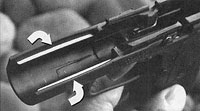 A steel insert is molded into the CW9's frame ensuring slide rides on stainless rails.
A steel insert is molded into the CW9's frame ensuring slide rides on stainless rails.
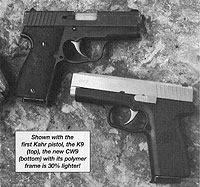 Shown with the first Kahr pistol, the K9 (top), the new CW9 (bottom) with its polymer frame is 30% lighter!
Shown with the first Kahr pistol, the K9 (top), the new CW9 (bottom) with its polymer frame is 30% lighter!
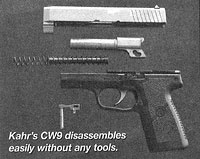 Kahr's CW9 disassembles easily without any tools.
Kahr's CW9 disassembles easily without any tools.
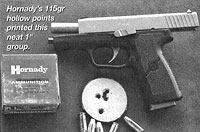 Hornady's 115 gr hollow points printed this neat 1" group.
Hornady's 115 gr hollow points printed this neat 1" group.
 The CW9 uses a pinned polymer front sight instead of the dovetailed sight that the P9 uses.
The CW9 uses a pinned polymer front sight instead of the dovetailed sight that the P9 uses.
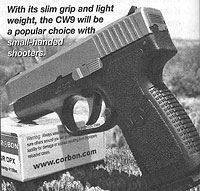 With its slim grip and light weight, the CW9 will be a popular choice with small-handed shooters.
With its slim grip and light weight, the CW9 will be a popular choice with small-handed shooters.
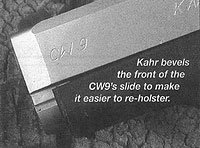 Kahr bevels the front of the CW9's slide to make it easier to re-holster.
Kahr bevels the front of the CW9's slide to make it easier to re-holster.Since the introduction of their first pistol in 1996, the Kahr family of guns has been recognized by serious handgun aficionados for their quality, accuracy and reliability. Their smooth double-action-only (DAO) triggers and petite dimensions have made them a favorite with those who carry a gun on a daily basis. While the price of these guns is comparable to that of any well-made American gun, it still put the guns outside of the comfort zone of many shooters. In an effort to present American shooters with a more affordable gun, Kahr has introduced the new CW9.
Kahr used its ever popular P9 pistol as a template to produce a pistol that is a full 20% cheaper without sacrificing its celebrated performance. According to Frank Harris, Kahr Arms Vice President of Sales and Marketing, "This is an entry level gun. Our plan is to broaden our market share and reach out to a different consumer base. Instead of buying a Ruger or Taurus we'll now put a Kahr pistol within their reach." While the new CW9 may be a "no frills" Kahr, it certainly doesn't seem to be lacking anything. But before we got to the CW9 let's take a look at the development of Kahr's polymer semi-autos.
When Kahr Arms rolled out the K9 in 1966, it was the smallest 9mm auto on the market. The single stack, double-action-only displayed impeccable workmanship and my test sample was extremely accurate. But, despite its petite dimensions, the all-steel pistol weighed in at a hefty 25 ounces unloaded. Even though many shooters made the K9 their new carry gun, me included, Kahr was inundated with requests for a lighter gun.
Kahr looked at developing an alloy frame pistol but was unable to find a material that could survive extensive firing and, instead, turned their attention to developing a polymer framed gun. In 2000, Kahr introduced the P9, a lightweight polymer framed version of the original K9.
Development of the polymer Kahr guns lasted over two years but resulted in a pistol that was over 30% lighter. Just for comparison, that's about half the weight of a steel framed 1911! Furthermore, because the grips are actually molded into the polymer frame, the grip circumference is 20% smaller. These two facts have made the P9 an especially good pick for women and those with small hands. Kahr molds a stainless steel insert into the plastic frame and dust cover, so that the slide reciprocates on stainless rails. The grip area is textured for a secure hold and the magazine well is beveled for speed reloads.
When the polymer gun was first introduced I did extensive shooting with it alongside the K9 and found that even though the gun is about a half pound lighter it was every bit as controllable as its steel frame counterpart. There was no measurable difference on my time between shot during rapid-fire exercises. One of the key reasons the Kahr guns are so controllable is their low bore axis in relationship to the shooter's hand. Kahr's patented offset feedramp allows the trigger mechanism to ride next to the barrel lug instead of under it. The result is much less noticeable muzzle flip.
Gun Details
So, just what will shooters give up by going to the CW9 instead of the P9 pistol? Not a whole lot, in my book. While Kahr calls the CW9 an entry level gun I don't see a lot of difference between it and the P9. For starters, the CW9 has a different slide contour than the P9. Less time spent in the CNC fixture equals money saved. Even though the lines differ slightly, the internal machining is exactly the same. Internal parts like the striker, firing pin and extractor (which by the way, pulls double duty as a loaded chamber indicator) are exactly the same parts used in the P9 gun. Instead of dovetailing the front sight, Kahr drills two holes into the slide so that the polymer sight can be melted in place. This arrangement precludes replacing the front sight with a tritium night sight. Of course, if you decide somewhere down the road that you need a night sight you can always take the slide to a gunsmith and have him dovetail it. The rear sight is steel and sits in a dovetail.
Rather than rollmark the slide with the company's name and model, like they do on the P9, the slide is simply engraved with legends: CW9 and KAHR. The muzzle of the CW9 is heavily beveled, giving it a neat streamlined appearance. As a practical matter it makes re-holstering the pistol easier.
The Kahr slide travels on four steel inserts or rails, two of which are inside the frame's dust cover, with the rear two at the extreme top back portion of the frame. The guns' weights range from 14-plus ounces to 27 ounces (unloaded), depending on their construction-all steel or polymer frame and steel slide.
Kahr has always used the excellent Lothar Walther barrels featuring polygonal rifling. These barrels provide outstanding accuracy because their rifling deforms the projectile less than conventional rifling. It also provides a better gas seal with the bullet thereby increasing velocity. And, without the sharp lands and grooves, makes cleaning the barrel easier. So, it was not without a great deal of contemplation that Kahr decided not to use the Walther barrels in the CW9. Instead they decided to use a barrel with traditional-style cut rifling. Kahr's Frank Harris told me that, after some experimentation, they found that their rifled barrels provided a comparable level of accuracy, but there is a chance velocity might drop a bit. This however, was not what I discovered - more on this later.
Harris also told me that the slide stop on the CW9 is a MIM part compared to the machined slide stop of the P9. MIM stands for Metal Injection Molding and it is a process that involves heat and pressure to produce a part 95% as dense as a forged and machined part. It's a process that has become increasingly popular among firearms manufacturers for the sake of economy. Kahr increased the width of the barrel's lug, which cams on the slide stop pin during the locking and unlocking of the barrel, to provide more surface area and reduce the chances of the slide stop pin shearing. I asked Harris if the slide stop really costs enough to make a difference in the pricing of the gun. It does! The MIM part costs less than 1/6 the price of the machined slide stop.
As far as the top end of the gun, those are the only differences between the P9 and the CW9 pistols. As for the frame, well, they are exactly the same for both models. According to Kahr's Harris, there's not one difference between the frames and their internals of the P9 and the CW9 guns. Kahr, however, ships the CW9 with one magazine compared to two with the P9.
Shooting Impressions
The trigger pull of my CW9 registered a smooth 5.5 pounds and made the little lightweight a pleasure to shoot. If you haven't tried a Kahr trigger, the best way for me to describe it would be to imagine the finest double-action revolver trigger you've ever tried and then think how light and smooth it would be if it didn't have the mass of the cylinder to rotate.
I shot the CW9 for accuracy from a bench with my targets set up 15 yards distant. I used Shoot-N-C one-inch target pasters for an aiming point and fired five shots per group using a Millet BenchMaster for support. Hornady's 115-grain hollow points turned in the best group of the day, placing five shots into a neat little cluster that measured just one inch. Recoil with the lightweight was not a problem at all, even with the hotter defense ammo - the CW9 is a fun little gun to shoot!
On another day I took a steel target, which approximates the head and shoulders of a man, to see just how controllable the CW9 was. The results impressed me. Using a PACT electronic timer to measure my times, I was able to place two hits on the target with a time between shots of just 3/10ths of a second from a distance of about 15 yards.
I took my Kahr K9 along with me when I went out to chronograph the CW9. I wanted to investigate the difference in velocity between the polygonal rifled barrel of the K9 and the cut rifling of the CW9. Using a PACT chronograph, I found that there was a deficit in velocity, though not by much. With the ammunition that I tested, the CW9 turned in velocities that were, on average, 1% less than those of the polygonal rifled K9. With the accuracy of the CW9 and the fact that the velocities were nearly identical, I don't see any compromise in choosing the CW9 over the P9.
CW9 Carry
For a lightweight polymer pistol I figured that the perfect concealed carry holster should also be made a lightweight polymer. I chose a Fobus C-21B paddle holster. Loaded with eight rounds of Cor-Bon's 115-grain DPX hollow points the CW9 weighs a feathery 21 ounces and sitting in the Fobus holster, it was so comfortable I often forgot I was wearing a pistol. But what I really like about this holster is the easy-on easy-off capability. No need to unthread your belt through the loops to take the holster off or put it on. The holster features some rather significant anchors on its paddle and despite thousands of presentations there was never an instance when I made a grab for the pistol and pulled the holster out with it. There's an adjustment screw on the holster towards the bottom of the trigger guard that allows the user to adjust the amount of tension used to retain the gun. The only thing that I don't like about the holster is its butt-for-ward rake. It used to be called the FBI cant in the old days and I prefer a more neutral, straight up and down position for carry. Fobus does offer their Roto-Holster with an adjustable angle of cant, though their website doesn't show it yet being offered for the Kahr P9 and CW9.
It's July as I write this, and here in Southern Arizona temperatures are hovering around 110 degrees. When it gets this hot, it becomes burdensome to carry anything more than absolutely necessary, so the heavy 1911s and leather gear stays in the gunsafe. Wearing shorts and an untucked T-shirt, the CW9 with the Fobus holster was easy to conceal behind my right hip. This lightweight setup doesn't make my waistband sag and the plastic paddle doesn't chafe me even when I'm sweating. For hot weather carry, what could be better than the lightweight and corrosion-resistant CW9 sitting in a mildew and rot-resistant Fobus paddle holster?
Final Notes
If you like the idea of a lightweight, concealable and easy to control 9mm semi-auto and can live without a dovetailed front sight and an extra magazine, the Kahr CW9 should hold a lot of appeal. It possesses the legendary Kahr quality, reliability and accuracy needed for a lightweight defense pistol. Its suggested retail price is $533, that's $143 cheaper than the P9's suggested retail price, but it's my bet that you'll find it substantially cheaper in your local gun shop. Unfortunately, Kahr has no plans at this time to release an economy version of the PM9, their hugely poplar subcompact version of the P9.
| Performance: Kahr CW9 9mm | ||||||||||||||||||
|
||||||||||||||||||
| Bullet weight measured in grains, velocity in feet per second (fps) over PACT Chronograph, accuracy in inches for 5-shot group fired at 15 yards from seated rest over Millett BenchMaster. |